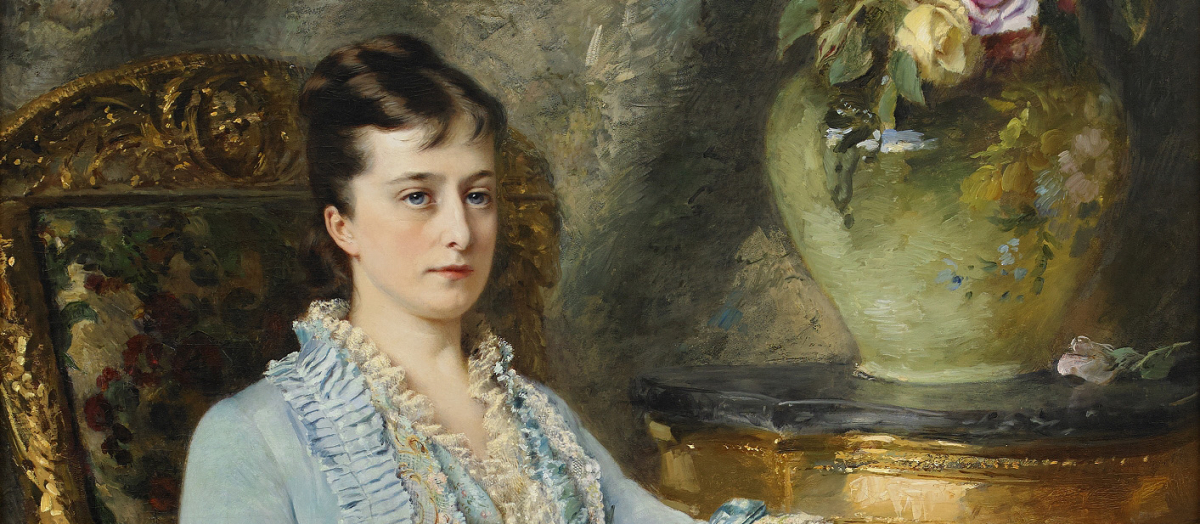
2017-09-05
Nyupptäckt ryskt kejserligt porträtt
Stockholms Auktionsverk har fått i uppdrag att försälja Konstantin Makovskys magnifika porträtt av prinsessan Yurievskaya, den ryska tsaren Alexander II:s andra gemål. Se vår specialist Pierre Olbers Saint Bellies presentera porträttet och läs Elena Nesterovas text om målningen.
Målningen har efter mer än hundra år nu återupptäckts och kommer att försäljas på höstens Klassiska auktion den 13 december.
Elena Nesterova, världens främsta expert på Makovsky, berättar om den magnifika målningen.
The portrait depicts Catherine Dolgorukova (1847-1922), from 1880 – her Imperial Highness Princess Yuryevskaya, the second, morganatic, wife of Russian Emperor Alexander II. Their marriage did not last long, just one year because of the tragic premature death of the emperor. The first acquaintance with Catherine, when she was still a young girl, took place in 1859, when Alexander II stayed with Prince Dolgorukov on the estate of Teplovka near Poltava, during military exercises organized on the occasion of the 150th anniversary of the Battle of Poltava. Soon afterwards Catherine’s father was financially ruined, and the emperor took the children into his care: four brothers and two sisters. The girls were sent to the Smolny Institute. On Palm Sunday in 1865, Alexander II, when visiting the Smolny Institute, was presented to the seventeen-year-old Ekaterina Dolgorukova, whom he remembered. He immediately fell under the charm of the young girl. They began to meet secretly, and soon Catherine became the Emperor’s favorite. At that time, the Empress Maria Alexandrovna was already sick with consumption and bed-ridden. The liaison between the emperor and Catherine Dolgorukova caused great displeasure to many of the Romanov family and, above all, to the Tsarevich, the future emperor Alexander III. But their attachment of was strong, sincere, mutual and stood the test of time. Even before their marriage, Ekaterina gave birth to four children to the Emperor: George (1872-1913), Olga (1873-1925), Boris (1876, died in infancy), and Catherine (1878-1959). After the death of Empress Maria Alexandrovna on May 22, 1880, and before the expiration of the period of mourning, on July 6, 1880, in the military chapel of the Tsarskoye Selo palace, the marriage of Alexander II and Catherine Dolgorukova took place, and in December she was granted the title of Princess Yuryevskaya, which was related to one of the family names of the boyar Romanovs. The children, legitimised retrospectively, also received the surname Yurievsky.
Konstantin Egorovich Makovsky – the last great Russian painter of Russia, ”the artistic ceremony master,” as he was called by contemporaries, painted many portraits of the emperor and of his family members. It was not for nothing that Alexander II called him ”my artist”. Konstantin Makovsky had the opportunity to personally communicate with the emperor, who repeatedly posed for him. Sergei Makovsky writes about this in great detail; one of the chapters of the memoirs ”Father and My Childhood” is called ”Portraits of Alexander II”.
As Sergei Makovsky recalled, at the beginning of summer of 1880, the young Imperial couple retired to the Livadia Palace in the Crimea. Work immediately began on three portraits: that of the emperor, of his young wife, and of their children: George, Olga and Catherine. The atmosphere in which these works were created was the warmest. Sergei Makovsky recalls: ”In the Livadia atmosphere, he (the emperor – E.N.) impressed everyone by his simplicity and cordiality. As the portraits of his wife, son and daughters were being painted, he attended all the sessions, gave cautious advice, joked, affectionately scolded the naughty Gogu, and as a parting gift gave his father (K.E. Makovsky-E.N) candy and flowers to his ”beautiful wife” (Yu.P. Makovsky-EN) ”.
Begun in Livadia, the portraits were finished in Petersburg. As Sergei Makovsky reported: ”The sessions were interrupted by the Tsar’s departure with his family to St. Petersburg, and the portraits were finished later. My father succeeded at once with the faces and heads of the Emperor and Princess Yuryevskaya; the bodies were added later, posed by models. Moreover, in St. Petersburg, before his death, the sovereign repeatedly posed for his father, and the children were also brought to my father’s studio later, when the effects of the (assassination) of March 1 had quietened down ” The location of the original portrait of Alexander II (with his dog, Milord, sitting at his feet) is unknown, but several copies were made by the artist and one of these is kept in the State Tretyakov Gallery. ”Portrait of the Children of the Her Imperial Highness Princess Yu.” Was published in 1915 in the journal ”Niva” (No. 42, p. 770); now it is in a private collection. But the portrait of the princess Yuryevskaya disappeared from the view of specialists for a long time.
To establish the identity of the model presented here we were helpednot not only by the lady’s resemblance to the famous photographs of the Princess, who was blue-eyed and dark-haired, had thin lips, a rounded chin and a characteristic nose shape, but other arguments alos. First of all, the date on the image – 1880, as we recall from the memoirs of the painter’s son, was precisely when the work on the entire series was carried out. Sergei Makovsky mentions the blue hood of Princess Yuryevskaya, in which she posed for the artist, which coincides with the color of the clothes depicted. It is also significant that the dimensions of this portrait (190×107 cm) are close to the size of the portrait of children (191×111 cm). The accessories in the two portraits also form a single ensemble; the basket with flowers in the lower left corner at the feet of children finds a response in a vase with flowers on the right above the head of the Princess.
The portrait of Princess Yuryevskaya was shown at the XX11 exhibition of the St. Petersburg Society of Artists in 1913, as indicated in the exhibition catalog, after which all traces of it were lost for a long time; now we can again appreciate this exceptional work by the outstanding artist.
